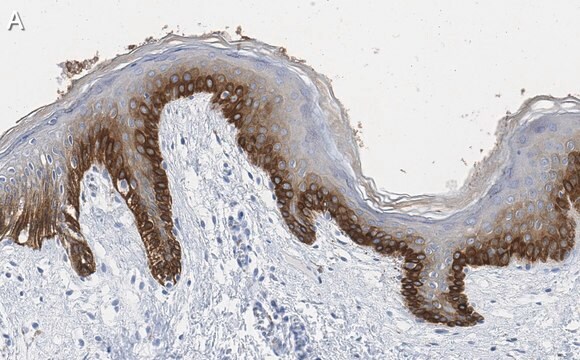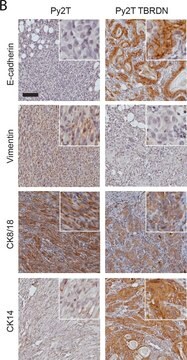Key Documents
C5992
Anti-Cytokeratin, pan antibody, Mouse monoclonal
clone PCK-26, purified from hybridoma cell culture
Synonim(y):
Monoclonal Anti-pan-Cytokeratin, Anti-Cytokeratin, Anti-Cytokeratin - Monoclonal Anti-Cytokeratin, pan antibody produced in mouse
About This Item
Polecane produkty
pochodzenie biologiczne
mouse
Poziom jakości
białko sprzężone
unconjugated
forma przeciwciała
purified from hybridoma cell culture
rodzaj przeciwciała
primary antibodies
klon
PCK-26, monoclonal
Postać
buffered aqueous solution
reaktywność gatunkowa
human, chicken, snake, hamster, pig, goat, feline, bovine, carp, rat, rabbit, canine, lizard, sheep, mouse, guinea pig
opakowanie
antibody small pack of 25 μL
stężenie
~1.5 mg/mL
metody
dot blot: suitable
immunocytochemistry: suitable
immunohistochemistry: 10-20 μg/mL using human placenta or skin
western blot: suitable
izotyp
IgG1
Warunki transportu
dry ice
temp. przechowywania
−20°C
docelowa modyfikacja potranslacyjna
unmodified
informacje o genach
bovine ... Krt1(100301161)
dog ... Krt1(444857)
human ... KRT1(3848) , KRT1(3848) , KRT1(3848) , KRT5(3852) , KRT5(3852) , KRT5(3852) , KRT6A(3868) , KRT6A(3868) , KRT6A(3868) , KRT6B(3854) , KRT6B(3854) , KRT6B(3854) , KRT8(3856) , KRT8(3856) , KRT8(3856)
mouse ... KRT1(16678) , KRT1(16678) , KRT1(16678) , Krt1(16678) , Krt5(110308) , Krt5(110308) , Krt5(110308) , Krt6a(16687) , Krt6a(16687) , Krt6a(16687) , Krt6b(16688) , Krt6b(16688) , Krt6b(16688) , Krt8(16691) , Krt8(16691) , Krt8(16691)
rat ... Krt1(300250) , Krt2-5(369017) , Krt2-5(369017) , Krt2-5(369017) , Krt2-8(25626) , Krt2-8(25626) , Krt2-8(25626)
Szukasz podobnych produktów? Odwiedź Przewodnik dotyczący porównywania produktów
Opis ogólny
Specyficzność
Immunogen
Zastosowanie
Immunofluorescence (1 paper)
- immunoblotting
- immunohistochemistry
- Immunocytochemistry
- dot blotting
Działania biochem./fizjol.
Postać fizyczna
Oświadczenie o zrzeczeniu się odpowiedzialności
Nie możesz znaleźć właściwego produktu?
Wypróbuj nasz Narzędzie selektora produktów.
polecane
produkt powiązany
Kod klasy składowania
12 - Non Combustible Liquids
Klasa zagrożenia wodnego (WGK)
WGK 1
Temperatura zapłonu (°F)
Not applicable
Temperatura zapłonu (°C)
Not applicable
Certyfikaty analizy (CoA)
Poszukaj Certyfikaty analizy (CoA), wpisując numer partii/serii produktów. Numery serii i partii można znaleźć na etykiecie produktu po słowach „seria” lub „partia”.
Masz już ten produkt?
Dokumenty związane z niedawno zakupionymi produktami zostały zamieszczone w Bibliotece dokumentów.
Nasz zespół naukowców ma doświadczenie we wszystkich obszarach badań, w tym w naukach przyrodniczych, materiałoznawstwie, syntezie chemicznej, chromatografii, analityce i wielu innych dziedzinach.
Skontaktuj się z zespołem ds. pomocy technicznej








